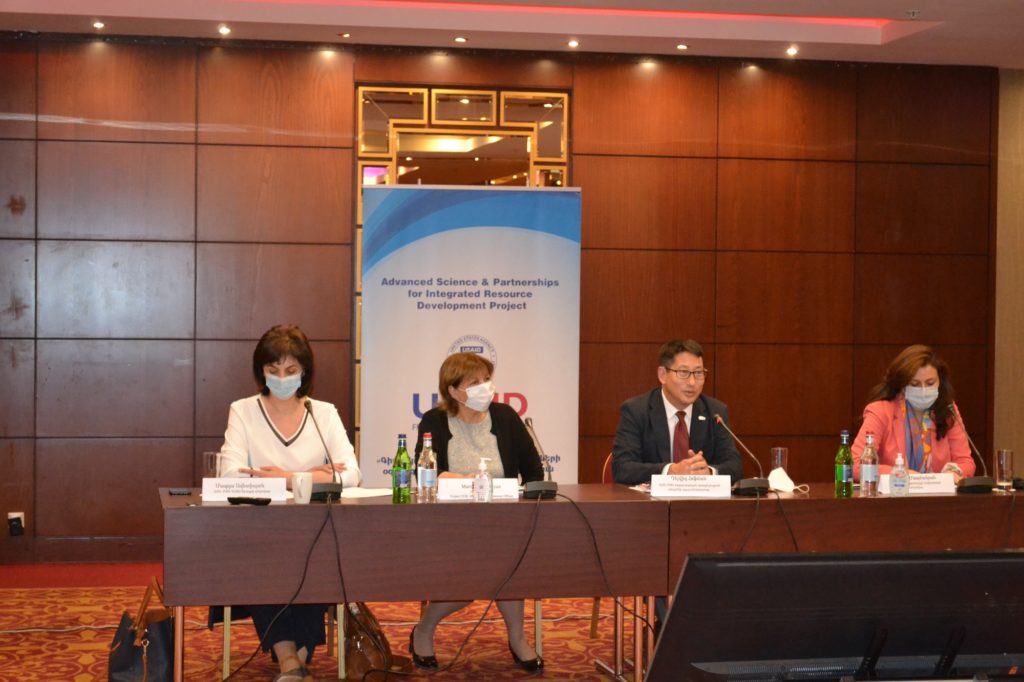
Today the Conference “Prospects of Sustainable Water Resources Management in the Ararat Valley” took place in Yerevan to discuss the water challenges in the region and their negative consequences for Armenia.
Organized by the USAID’s Advanced Science and Partnerships for Integrated Resource Development (ASPIRED) Project, the Conference unveiled the current state of the artesian basin and the potential for long-term conservation and sustainable use of the groundwater resources in the Ararat Valley.
During the Conference, the ASPIRED Project presented the values of estimated groundwater reserves, recharge rates and the sustainable volume of the groundwater abstraction from the artesian aquifers of the Ararat Valley. The water supply and demand estimates point to a significant water deficit in the region, mostly caused by intensive human activity and resource overuse by different sectors. According to the data of 2016, the negative difference between water supply and demand in the Ararat Valley artesian basin was estimated to 1,120 mln. cubic meters of water.

Until recently, the Government decisions on the groundwater abstraction levels were based on the data of 1983-1984. The Government introduced the policies and regulations to curb the over-abstraction and regulate activities of water users. Yet, the ASPIRED Project data shows there is still a 46% gap between the actual volume of groundwater abstracted in the Ararat Valley in 2016 and the sustainable rate enacted by the Government.
“For over 25 years, the United States Government and the Government of Armenia have cooperated to address challenges in the water sector. In order to best support this effort, we needed access to data. How can we know how much water is being lost, and how best to address it, without real-time numbers? But the data being used was almost 40 years old. We knew that in order to really understand the amount of water loss in the Ararat Valley, that we would need more current information. That is where USAID’s support came into play. We hope that through this collaboration, we will all be able to help restore water reserves in this critical region for agriculture and home to the Metsamor Nuclear Power Plant” – David Hoffman, USAID/Armenia Acting Mission Director.
Anna Mazmanyan, Deputy Minister of Environment of Armenia, highly appreciated the efforts of USAID and ASPIRED Project.
“The comprehensive studies on hydrological and hydrogeological conditions in the Ararat Valley conducted by the ASPIRED project are especially important in terms of analyzing the source, properties and condition of groundwater resources. This is necessary for identifying the technical solutions for the use of these resources. Being the most precious natural resource, artesian water is widely used both for drinking and economic purposes. The findings presented in the project report will enable us to develop a comprehensive and integrated approach to sustainable management of water resources…” -Deputy Minister Mazmanyan.
The data presented by the ASPIRED project can serve the basis for the Government of Armenia to elaborate balanced water sector policies and regulations, which give priority to the long-term resource conservation objectives while meeting the region’s water needs. This essentially calls for action by the private and public water users – local communities, energy, industries, farms. fish-farms, and the larger public – towards a more conscious approach to water consumption and adoption of water saving technologies.
The artesian basin contains significant groundwater reserves used for domestic, irrigation, fish-farming and industrial purposes. Water is also used for cooling of Metsamor power plant. The studies revealed that the groundwater levels have decreased by 6.0-9.0 meters on average (up to 15 meters in some places), and the artesian zone has shrunk by around 67% over the recent decade. The negative over-exploitation dynamics disturbs the water balance and the recharge potential of the aquifer, reducing the region’s water availability and putting the country’s food and energy security at risk. Over 30 communities in the Ararat Valley face drinking and irrigation water problems due to resource depletion.










